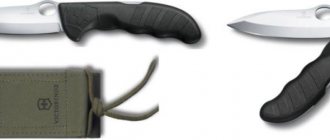It is difficult to find a knife that is more entangled in myths than the Yakut one. Even the NKVD knife and a variety of plastun and boot knives are inferior to him. The phenomenon of the popularity of the Yakut knife is mixed with the revival of the national self-awareness of the Yakuts, and marketing, and simply the fashion for exotic knives. Just like 5 years ago, there was a wave of Finnish knives, in different guises.
So what is a Yakut knife? A working miracle all-rounder, as numerous workshops position it, or just a product of marketing? Let's try to figure it out.
History of origin
In general, the first people appeared on the territory of the modern Republic of Sakha quite a long time ago, more than 300 thousand years ago. But the massive movement of the ancestors of the Evenks and Tungus from Transbaikalia began in the middle of the first millennium AD. Turkic-speaking tribes moved to the North in several waves, forced out of their ancestral lands by the pressure of more developed cultures. By the 12th century. Tungus tribes settled widely in the vicinity of the Middle Lena. After which they were pushed back by the ancestors of the Yakuts to the east of the Lena, in the last wave of resettlement during the XIV-XV centuries.
The settlers carried with them the skills of a nomadic lifestyle and metal processing. But having found themselves in different, unusual conditions of the Far North, the Yakuts had to adapt to them. Thus, comfortable but heavy yurts disappeared from everyday life. The carts were replaced by sledges, which were pulled by small draft reindeer.
It should be noted that the process of settlement of the Yakuts was predominantly peaceful; armed conflicts with neighbors occurred quite rarely. What determined the influence on the weapons complex of Yakut men, in this case I mean that the Yakut belt knife was poorly adapted to defeat the enemy. It was a typical household tool, mainly created for performing work in the camp and while hunting.
In general, the Yakut knife stands out noticeably against the background of other ethnic knives. Large wooden handle, egg-shaped. In which the blade is immersed using a mounted mounting on a chopik. Formed by characteristic asymmetrical slopes. On the one hand, the descent is flat from the butt, usually on this side it is done using forging, and on the other side there is a flat lens.
There are several basic concepts of the origin of the Yakut knife.
The first says that this shape of the blade is due to the influence of tradition. Initially, knives were made from stone and bone, and if you split the tubular femur, you get the profile of a Yakut knife. Moreover, it should be noted that the first Russian settlers mentioned that the Yakuts, along with steel knives, used bone knives of a characteristic shape for sanding and dressing skins. After the Yakut tribes acquired metal processing skills, they continued to make the blades of their working knives, in the image and likeness of those used by their ancestors.
The second hypothesis is based on the technological aspect of knife production. In conditions of an acute shortage of high-quality metal, one of the options for how a small piece of steel can be accelerated to the size of a large blade is forging a fuller. When forging a fuller, in the conditions of a primitive forge, the second side of the blade was automatically obtained with a convex lens.
The third hypothesis is based on the combat aspect, when in order to reduce the weight of long-bladed weapons, a dol was performed on the blade. This made it possible to reduce the weight of the blade while maintaining the necessary strength. But such weight savings make sense when the blade is long, about a meter. But on a knife, there is no winning as such.
From the history of the Yakut knife
During excavations in modern Yakutia, artifacts were found indicating that indigenous peoples have long used cutting tools and valued them very highly. In Yakut traditions, it was believed that giving a knife means sharing a piece of your happiness. The true story of its appearance is hidden in the depths of centuries.
The fate of the indigenous peoples of the North and, in particular, the Yakuts, has not been fully studied and is filled with many myths and legends associated with its customs and traditional way of life. Some researchers believed that in ancient times they used bone products, but the study of finds indicates that the people used an iron Yakut knife of a completely unusual shape.
The peculiarities of its design still cannot explain, nor can they understand why the nomadic people, who lived in harsh conditions, had blacksmiths who made metal cutting tools.
The only thing that was established for certain was that it was used mainly for domestic purposes, but in case of danger, they could also use it as a combat edged weapon, which was quite rare.
Features of blade geometry
In general, Yakut-type knives are divided into two types according to the width of the blade:
- Tundra;
- Taiga.
The first has a very narrow blade, which is due to the fact that the wide blade, after cutting a deer in the cold, could easily freeze to the sheath from the inside. It is designed for whitening deer and using it as a carpenter's tool for repairing equipment. The taiga knife has a much wider blade, since its area of use is further south, where the climate is somewhat milder.
According to the length of the blade we can distinguish:
- Bykhycha;
- Bychakh;
- Khotokhon;
- Batuya.
Bykhycha is a small, household knife, with a blade of about 80-100 mm. As a rule, it is used by women and children when doing housework. Typically, such knives are given to children aged 5 to teach them to work.
Bychakh is the hunter’s main knife, with a blade 110-170 mm long. With its help, all work is performed during hunting, fishing, and preparing camp food. Equipment is being repaired.
Khotokhon is a powerful chopping knife with a blade over 170 mm. It was used both as a combat weapon and for performing heavy, rough work.
Batuya occupies the ecological niche of a machete or an ax. Its blade is about 500 mm long, and its long handle, which allows you to use both hands when striking, allows you to cut a road in the bush, chop firewood, and, if necessary, fight back a predatory animal or a bad person. Interestingly, for the most part, Yakut knives are designed for use with the right hand. That is, the lens is on the left side, and the flat release is on the right. The batyya has a reverse blade geometry. This is due to the fact that, as a rule, a right-handed person delivers a slashing blow in the direction from right to left, and the batyya’s blade fits well into this trajectory.
Yakut knives. Varieties
Based on the length of the blade, there are several varieties of the traditional Yakutia knife:
- “Bykhycha” – from 8 to 11 cm. Designed for children and women, as well as for small work.
- “Bychakh” - from 11 to 17 cm. The most popular variety, which has become the most widespread.
- “Khotokhon” - more than 17 cm. More often used as a military weapon, less common.
- “Batuya” is a half-meter (sometimes longer) sword, the blade is curved, but has all the same characteristic features.
If you look at the blade from above, from the side of the butt, the fuller will be on the right. Knives with mirror asymmetry were made for left-handed people.
Handle design and ergonomics
The handle of the knife is usually made of birch burl soaked in oil. Its length is 130-150 mm, which allows you to work effectively with a knife in the cold season, when your hand is covered with warm mittens. The shape is ovoid, with the sharp end down. This allows you to correctly position the knife in your hand without looking. The blade is mounted in a mounted manner, the shank is fixed using a chopper and glue.
Overall, despite its simplicity, if not primitive shape, the handle of the knife is extremely comfortable. Both for power work and for delicate work. The shape of the handle is traumatic, so when working it is necessary to control the position of the fingers in order to avoid cuts due to the fingers sliding onto the cutting edge.
The knife is usually equipped with a leather or wooden sheath, which in turn is covered with oxtail leather, submersible type. The fit of the knife in the sheath is tight, but the knife can be easily removed by pressing the thumb into the mouth of the sheath. The suspension is free, in the form of a leather cord. The knife is worn on the right or left side, depending on which hand the owner has working.
Yakut knives. Sheath
Another unique detail of the “Yakut” is its original scabbard. An authentic manufacturing method is considered to be the use of oxtail leather, removed in the form of a single sleeve or sock, inside which a liner made of durable wood was inserted.
The knife is immersed in the sheath along with part of the handle, which is wrapped around the leather part of the sheath and thus held in it. The blade is not clamped by a wooden insert; its task is to prevent the blade from breaking or bending.
The scabbard is hung on a loose leather garter at the front left. The blade is directed horizontally, the handle points to the right. As a result, a hunter or warrior can quickly draw a weapon with his right hand while holding the sheath with his finger.
Advantages and disadvantages of the Yakut knife
The geometry of the Yakut knife has both certain advantages and disadvantages.
The advantages include the simplicity of the sharpening process. In order to sharpen a knife, you need to place its flat side on the abrasive and bring it to the desired sharpness. After a burr appears on the cutting edge, you should run the abrasive over the convex lens to remove it.
It must also be said that the knife works excellently, almost like a plane, on wood. You can either remove thin chips in a controlled manner or tear out large pieces of wood. Depending on which side of the knife the work is being done.
The knife works great for cutting meat, skinning hunted animals, or for filleting fish. The geometry of the blade allows you to carefully remove meat from the bone without catching it with the cutting edge. Which ensures its safety. The knife works quite well in the kitchen, at home, of course, when slicing the famous stroganina from fish or venison. Or on a hike.
The disadvantages of the knife stem from its advantages. Due to the asymmetrical geometry of the blade, the knife noticeably moves to the side when cutting hard foods, such as potatoes. Yes, to be fair, this doesn’t make it any less tasty in a camp stew. But the fact has to be. And you have to get used to controlling the knife while working. Also, when working with wood, you have to constantly intercept the workpiece in different positions in order to remove the required volume of wood in a controlled manner.
Conclusions:
To summarize, we can conclude that the Yakut knife is a common working tool of the northern hunter. It does not have any miraculous properties, but is made so by the experienced hands of its owner. It has certain advantages and disadvantages, like all other knives. Having it in your collection is a good choice. You should decide for yourself whether to use it while hunting or on a hike. Based on what work is most often expected to be performed. If this is woodworking, and cutting/smoking an animal while hunting, a Yakut knife is ideal for such work. It will be a little less convenient for the kitchen.
Yakut knife. History, features, legends
For a person. who is forced to exist in the wild for a long time, a knife is not just a symbol, a weapon or a source of pride. This is, first of all, the main working tool. And its parameters already depend on what kind of work needs to be done. Hence the huge number of different “national knives”, which are sometimes radically different from each other. So today we will talk about just one of these tools - the Yakut knife .
Story
Even during excavations of ancient Yakut burials, which were thousands of years old, bone knives were discovered that had a noticeable resemblance to a modern Yakut knife . As time passed, the material for the blades gradually changed, but the characteristic features remained exactly the same. And all because the conditions and purposes of application did not change at all. Hunting, butchering, wood carving, making national clothes - all this is done in almost the same way as hundreds of years ago. Traditions, however.
There are several varieties:
- small (bykhichcha), which is used mainly by women and children - blade length up to 110 mm.
- medium (bykhakh) – a typical Yakut knife, with a blade up to 170 mm
- large (hotokhon) - a military weapon with a blade from 170 cm. Quite rare.
During the Soviet era, the manufacture and carrying of such tools was prohibited, since the Yakut knife, in principle, can, with a stretch, be called a typical edged weapon, but more on that later. And few people cared that it was used extremely rarely for these purposes, but regularly in everyday life. Since it can be used as a weapon, it means it is prohibited. Fortunately, local leaders understood the specifics of this instrument, so the ban was rather formal.
Nowadays, there is a special resolution that allows representatives of the Sakha people to carry and make a Yakut knife , since it is an integral part of folk culture. True, this applies exclusively to indigenous residents. Everyone else has to follow the same rules as for ordinary edged weapons.
Peculiarities
At first glance, Yakut knife looks However, there are aspects characteristic of this knife: the blade is not only sharpened exclusively on one side - it is also slightly curved. And on the other side there is a dol. By the way, there are very different opinions regarding the origin of this dole - some believe that it is extremely necessary for blood flow, others that it allowed saving iron during forging. And if there is also a rather interesting opinion of a certain Kirpichev I.V., who in his works believes that the dol on Yakut knives is a banal copying of Russian edged weapons. And on the one hand, solely because the Yakuts could not figure out how to apply it to both at the same time. And it was precisely because of this that such a knife acquired a convex shape.
As for the handle, it was made from birch burl (an abnormal growth of wood fibers), impregnated with special oil. The length is up to 150 mm, which is slightly longer than the width of a man’s palm, so the knife fits quite comfortably in it. There are no stops. Sometimes the handle was still wrapped with birch bark and glued. And all sorts of “walrus tusks” and “mammoth tusks” are used exclusively for greater show off.
Opinions
The Yakut knife is a fairly effective working tool. Otherwise, how can one justify the fact that its structure has not changed for a hundred years? But it has its pros and cons. The main disadvantage is that it takes a long time to get used to. The straight handle is uncomfortable, the narrow part of the blade is too long, especially the tapered tip. At least, those who are forced to work with these tools for the first time complain about this. Asymmetrical sharpening, of course, makes the work a little easier, but you also need to get used to it.
Many people are annoyed by the lack of a normal finger rest. The classic polished birch handle glides in your hand. And not everyone likes Yakut knives Yes, this makes it possible to sharpen the knife in almost any conditions - even river pebbles. But no, in practice, if the knife is not used daily, such a need rarely arises.
Total. Yes, the Yakut knife is quite suitable for its purposes, but it just takes a long time to get used to it. Preferably from early childhood. It will be easier for everyone else to use more familiar, convenient and functional options.











